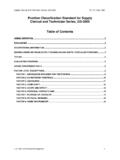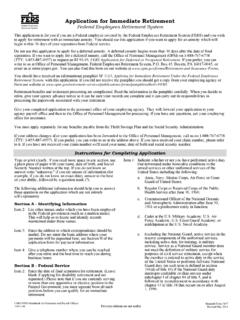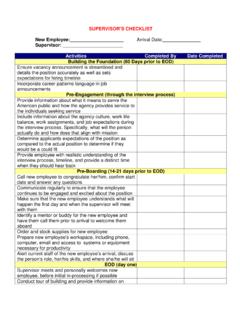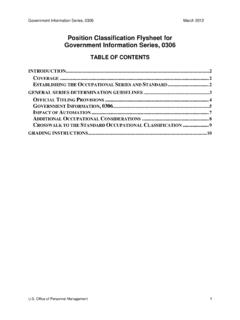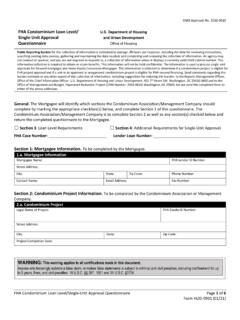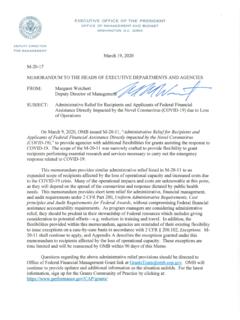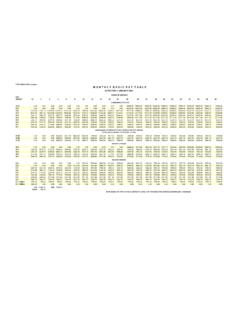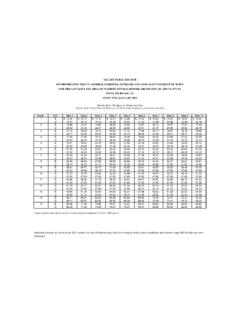Transcription of FSC Recommendations 2020 For 2022 - United States Office ...
1 Federal Salary Council 1900 E Street, NW. Washington, DC 20415-8200 January 6, 2021 MEMORANDUM FOR: THE PRESIDENT S PAY AGENT HONORABLE EUGENE SCALIA HONORABLE RUSSELL T. VOUGHT HONORABLE MICHAEL J. RIGAS SUBJECT: Level of Comparability Payments for January 2022 and Other Matters Pertaining to the Locality Pay Program EXECUTIVE SUMMARYAs authorized by the Federal Employees Pay Comparability Act of 1990 (FEPCA) and detailed below, we present our Recommendations for the establishment or modification of pay localities, the coverage of salary surveys conducted by the Bureau of Labor Statistics (BLS) for use in the locality pay program, the process of comparing General Schedule (GS) pay to non-Federal pay, and the level of comparability payments for January 2022. Except as otherwise noted below, these Recommendations represent a consensus of Council members. Where the Council could not reach consensus, the separate views of Council members are submitted for the President s Pay Agent to consider.
2 Recommendation 1: The Council recommends the Pay Agent adopt the locality pay rates set forth in Attachment 1 as those that, absent another provision of law, would go into effect under FEPCA in January 2022. Regarding this recommendation, however, we note as a reminder that, in accordance with its statutory charter, the Council undertook a thorough review and discussion of the salary survey methodology used in the locality pay program and provided Recommendations in that regard in the Council s May 2, 2019, report to the Pay Agent. In those Recommendations , certain Council Members recommended that the Pay Agent consider, establish, and fund alternatives to the current salary survey methodology and/or, alternatively, sponsor a more in-depth study of alternative methodologies to measure the disparity between Federal and non-Federal compensation and its resulting impact. Recommendation 2: The Council should continue to analyze and discuss the issue of whether the 2,500 GS employment threshold should change for evaluating Rest of US metropolitan areas for possible establishment as new locality pay areas based on pay disparities calculated using data from the NCS/OES Model.
3 In 2021, the Council Working Group should provide the Council with a recommendation on this issue. Recommendation 3: Because no Rest of US research areas meet the standard established by the Council for establishment as new locality pay areas based on pay disparities calculated using data from the NCS/OES Model, no new locality pay areas should be established at this time based on such pay disparities. Recommendation 4: Council members could not reach consensus on the issue of whether the Pay Agent should adopt the metropolitan statistical areas (MSAs) and combined statistical areas 2 (CSAs) delineated in Office of Management and Budget (OMB) Bulletin No. 20-01 for use in the locality pay program. However, Council members provided separate Recommendations on that issue, as detailed in Attachment 4. Recommendation 5: The Council should not recommend establishment of any new locality pay areas or areas of application at this time that do not meet approved criteria for such establishment.
4 However, the Council strongly endorses the approval of all appropriate pay flexibilities such as recruiting and retention incentives and/or special pay rates to the agencies that employ Federal workers in the two areas that submitted Human Capital Indicators (HCI) data that were sufficient to support further Council consideration: Charleston, SC, and Southern New Jersey, as defined by proposals the Council received in 2020 regarding those areas. Recommendation 6: For Carroll County, IL, and other areas that can demonstrate that the only reason they do not meet the GS employment criterion for areas of application is because they have vacancies that keep them below the threshold, the Council recommends that the GS employment criterion be waived. Note to the Pay Agent In addition to our Recommendations above, the Council invites the Pay Agent to consider the views individual Council members expressed on the future of Federal pay in the October 21, 2020, Council meeting.
5 Minutes of that meeting are posted on the OPM website at #url=Federal-Salary-Council. List of Attachments to These Council Recommendations Below is a more detailed discussion, including background and rationale, for each of t he Recommendations summarized above. Attachments referred to in this document are listed below. Attachment 1: FEPCA Locality Rates for 2022 Using Current Salary Survey Methodology Attachment 2: Explanation of NCS/OES Model and Pay Disparity Calculations Attachment 3: Pay Disparities in Current Rest of US Research Areas Attachment 4: Views of Council Members on OMB Updates to MSAs and CSAs Attachment 5: Geographic Structure of Locality Pay Areas Attachment 6: Locations that Contacted Council Staff about Locality Pay 3 BACKGROUND AND RATIONALE FOR COUNCIL Recommendations Recommendation 1: The Council recommends that the Pay Agent adopt the locality pay rates set forth in Attachment 1 as those that, absent another provision of law, would go into effect under FEPCA in January Regarding this recommendation, however, we note as a reminder that, in accordance with its statutory charter, the Council undertook a thorough review and discussion of the salary survey methodology used in the locality pay program and provided Recommendations in that regard in the Council s May 2, 2019, report to the Pay Agent.
6 In those Recommendations , certain Council Members recommended that the Pay Agent consider, establish, and fund alternatives to the current salary survey methodology and/or, alternatively, sponsor a more in-depth study of alternative methodologies to measure the disparity between Federal and non-Federal compensation and its resulting impact. Background and Rationale: As in previous years, this year the Federal Salary Council reviewed comparisons of GS and non-Federal pay based on data from two BLS surveys, the National Compensation Survey (NCS) and the Occupational Employment Statistics (OES) program. As explained in previous Council documents, BLS uses NCS data to assess the impact of level of work on occupational earnings, and applies factors derived from the NCS sample to occupational average salaries from OES to estimate occupational earnings by level of work in each locality pay area. Taken together, this is referred to as the NCS/OES Model.
7 (A further explanation of the NCS/OES Model and pay disparity calculations is provided in Attachment 2.) Based on that model, OPM staff calculated a weighted average of the estimated locality pay disparities as of March 2020. According to those calculations, the estimated overall disparity between (1) base GS average salaries excluding any add-ons such as GS special rates and existing locality payments and (2) non-Federal average salaries surveyed by BLS in locality pay areas was percent. Using these data, the amount needed to reduce the pay disparity to 5 percent (the target disparity established by FEPCA) averages percent. Thus, when existing locality pay rates averaging percent as of March 2020 are taken into account, the overall remaining pay disparity is estimated at percent. Accordingly, using data from the salary survey and the pay comparison methodology described above, we recommend the Pay Agent adopt the locality pay rates set forth in Attachment 1 as those that, absent another provision of law, would go into effect under FEPCA in January 2022.
8 Note that these locality pay rates would be in addition to the increase in GS base salary rates under 5 5303(a). This provision calls for increases in basic pay equal to the percentage increase in the Employment Cost Index (ECI) for wages and salaries of private industry workers, between September 2019 and September 2020, less half a percentage point. The ECI increased percent during that period, so the base GS increase in 2022 would be percent. Recommendation 2: The Council should continue to analyze and discuss the issue of whether the 2,500 GS employment threshold should change for evaluating Rest of US metropolitan areas for possible establishment as new locality pay areas based on pay disparities calculated using 1 In Attachment 1, those locality rates are listed in a table, in the column with the heading Local Rate (Target Pay Disparity). 4 data from the NCS/OES Model. The Council Working Group should provide the Council with a recommendation on this issue prior to the Council s next public meeting.
9 Background and Rationale: As noted in the Council s April 2020 Recommendations to the Pay Agent, the Council has reviewed Rest of US research areas for consideration as new locality pay areas since the implementation of the NCS/OES Model in 2012, when the Council set a threshold level of 2,500 GS employees for those research areas in order to focus on areas having the most employees. The Council agreed in those April 2020 Recommendations to study the question of whether that threshold should be reduced. The Council began consulting with BLS to research the issue in 2020, and that research is ongoing. The Council agreed in its October 21, 2020, meeting that it should continue to study the issue and that the Working Group should come up with a specific recommendation or Recommendations on the issue prior to the Council s next public meeting. Recommendation 3: Because no Rest of US research areas meet the standard established by the Council for establishment as new locality pay areas based on pay disparities calculated using data from the NCS/OES Model, no new locality pay areas should be established at this time based on such pay disparities.
10 Background and Rationale: The Council is now monitoring pay disparities in 38 Rest of US research areas not approved for establishment as separate locality pay areas. We studied pay disparities for these areas, compared to the Rest of US pay disparity, over a 3-year period (2018-2020), and the results are shown in Attachment 3. Using the Council s current methodology, none of the 38 research areas had a pay disparity exceeding that for the Rest of US locality pay area by more than 10 percentage points on average over the 3-year period studied, the standard established by the Council to tr igger a Council recommendation to establish a research area as a new locality pay area. Recommendation 4: Council members could not reach consensus on the issue of whether the Pay Agent should adopt the metropolitan statistical areas (MSAs) and combined statistical areas (CSAs) delineated in Office of Management and Budget (OMB) Bulletin No. 20-01 for use in the locality pay program.




